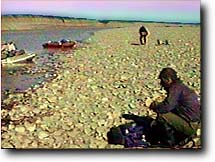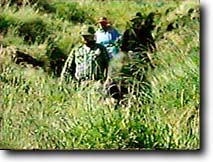
Branchiosaurus

We got an early start, not knowing why the Lord had delayed us from going further the day before. However, I was content and knew the Lord had things in hand. We traveled slowly, carefully checking out the west side of the river bank and bluff for bones. About 10:00, Buddy and Dan pulled over on a large sand and gravel bar along the base of the bluff. Would we have passed this island if we were in a hurry to get down the river the night before and had not been stopped by the dust storm? Probably. The Lord was in control.
The site turned out to be very fruitful. Mike and I both found two bones each in the bar gravels. They were all unfossilized and fairly large. I am still not sure if they are dinosaurian, but they certainly don’t belong to any modern animals. When collecting bones from stream gravels, there is a possibility you may occasionally turn up some mastodon or mammoth bones which are also be found on the North Slope. The bones that were found were kind of muddy, and only a small portion of them were sticking out of the mud and gravel. Since we found four bones relatively quickly, we thought more would be present.

BRANCHIOSAURUS All of the sudden, Buddy became very excited, he had also found something in the mud. He began to jump up and down an as he cleared the mud and sand away. It appeared as though he had found a long limb bone. His enthusiasm increased as he dug deeper and deeper. After he had cleared about eighteen inches or so of sand away, the shape began to look kind of funny. It was too good to be true, Buddy was digging out a piece of drift wood! All of the excitement was for naught. All were disappointed, but I think no one more than Buddy. I felt bad for him. Later, we were able to joke with him a little bit, and we referred to it as his “branchiosaurus” discovery.

We thoroughly investigated the bluff, finding no additional specimens. The view from the top was fantastic. We could see the Colville winding across the landscape for about ten miles in each direction. Dozens of small lakes could be seen dotting our panorama. From up here, the river no longer looked brown, but a beautiful deep blue. The sky was clear and the temperatures were relatively warm once again. There was a small stream that flowed off the tundra down to the gravel bar. The water was nice and clear and we took the opportunity to fill our canteens. We weren’t the only ones who use this small stream as a watering hole. There were worn animal trails in all directions leading to the stream. Tracks from nearly all types of tundra animals could be found (moose, caribou, wolf, marmot, bear, and goose, to name a few). The dust continued from yesterday. There is a lot of loess in Alaska which is a fine silty substance produced by the scouring action of glaciers. It is sometimes called rock flour, and is responsible for most of the dust and grit up here. The dust was certainly another surprise of the North Slope.
Rejoicing in our finds and the beautiful sunny weather, we had lunch and started down stream once again. But with stronger winds, we soon found ourselves grounded for four hours. We really would like to make it to the bone bed today, but it looks like it will have to wait until tomorrow.


